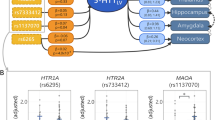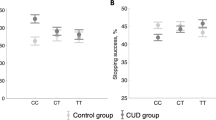Abstract
Knockout of the 5-HT1B gene in mice results in increased aggression, as well as alcohol and cocaine consumption. Given the clinical association of aggression, suicide, alcoholism, and substance abuse, we studied relationship of psychopathology to the human 5-HT1B receptor gene (N = 178) and postmortem human 5-HT1B receptor binding (N = 96) in the brain. The sample comprised: 71 suicide victims, 107 nonsuicides, 45 with a history of major depression and 79 without, 64 with a history of a alcoholism or substance abuse and 60 without, as well as 36 with a history of pathological aggression and 42 without. Single-strand conformational polymorphism (SSCP) analysis and DNA sequencing techniques were used to screen the coding region of the human 5-HT1B receptor gene in genomic DNA isolated from postmortem human brain tissue. Two common polymorphisms were identified in the 5-HT1B receptor gene, involving a silent C to T substitution at nucleotide 129 and a silent G to C substitution at nucleotide 861 of the coding region. These polymorphisms were found with the same frequency in the suicide and the nonsuicide groups and in those with and without a history of major depression, alcoholism, or pathological aggression. The binding indices (Bmax and KD of the 5-HT1B receptor in prefrontal cortex also did not differ in suicides and controls, major depression, alcoholism, and cases with a history of pathological aggression. The C129 or G861 allele had 20% fewer 5-HT1B receptor compared to the 129T or 861C allele. We did not identify a relationship between suicide, major depression, alcoholism, or pathological aggression with 5-HT1B receptor binding indices or genotype.
Similar content being viewed by others
Log in or create a free account to read this content
Gain free access to this article, as well as selected content from this journal and more on nature.com
or
References
Arango V, Ernsberger P, Marzuk PM, Chen J-S, Tierney H, Stanley M, Reis DJ, Mann JJ . (1990): Autoradiographic demonstration of increased serotonin 5-HT2 and β-adrenergic receptor binding sites in the brain of suicide victims. Arch Gen Psychiatry 47: 1038–1047
Arranz B, Eriksson A, Mellerup E, Plenge P, Marcusson J . (1994): Brain 5-HT1A, 5-HT1D and 5-HT2 receptors in suicide victims. Biol Psych 35: 457–461
Ballenger JC, Goodwin FK, Major LF, Brown GL . (1979): Alcohol and central serotonin metabolism in man. Arch Gen Psychiatry 36: 224–227
Boschert U, Amara DA, Segu L, Hen R . (1994): The mouse 5-hydroxytryptamine1B receptor is localized predominantly on axon terminals. Neuroscience 58 (1): 167–182
Brent DA, Bridge J, Johnson BA, Connolly J . (1996): Suicidal behavior runs in families. Arch Gen Psychiatry 53: 1145–1152
Crabbe J, Philip T, Feller D, Hen R, Wenger C, Lessov C, Schafer G . (1996): Elevate alcohol consumption in null mutant mice lacking 5-HT1B receptors. Nature Genet 13: 98–101
Coppen A . (1972): Indoleamines and affective disorders. J Psychiat Res 9: 163–171
Demchyshyn L, Sunahara RK, Miller K, Teitler M, Hoffman BJ, Kennedy JL, Seeman P, Van Tol HHM, Niznik HB . (1992): A human serotonin 1D receptor variant (5HT1Dβ) encoded by an intronless gene on chromosome 6. Proc Natl Acad Sci USA 89: 5522–5526
Gershon ES, Berrettini WH, Numberger JI Jr, Goldin LR . (1989): Genetic studies of affective illness. In Mann JJ (ed), Models of Depressive Disorder. New York, NY, Plenum, pp 109–142
Goodwin FK, Post RM . (1983): 5-hydroxytryptamine and depression: A model for the interaction of normal variance with pathology. Br J Clin Pharmac 15(suppl):393S–405S
Hamblin MW, Metcalf MA . (1991): Primary structure and functional characterization of a human 5-HT1D-type serotonin receptor. Mol Pharmacol 40: 143–148
Hartig PR, Hoyer D, Humphrey PP, Martin GR . (1996): Alignment of receptor nomenclature with the human genome: Classification of 5-HT1B and 5-HT1D receptor subtypes. [Review]. Trends Pharmacol Sci 17 (3): 103–105
Higley JD, Mehlman PT, Taub DM, Higley SB, Suomi SJ, Vickers JH, Linnoila M . (1992): Cerebrospinal fluid monoamine and adrenal correlates of aggression in free-ranging rhesus monkeys. Arch Gen Psychiatry 49: 436–441
Hoyer D, Middlemiss DN . (1989): Species differences in the pharmacology of terminal 5-HT autoreceptors in mammalian brain. Trends Pharmacol Sci 10: 130–132
Ishikawa K, Shibanoki S, Kubo T, Kogure M, Imamura Y, Osawa N, Ohmura M, Mikoshiba K . (1989): Functional difference in monoamine transmitters in the bahaviorally abnormal mouse mutant (wriggle mouse sagami). Neurosci Lett 103 (3): 343–348
Kelly TM, Mann JJ . (1996): Validity of DSM-III-R diagnosis by psychological autopsy: A comparison with antemortem diagnosis. Acta Psychiatric Scand 94: 124–130
Lappalainen J, Dean M, Charbonneau L, Virkkunen M, Linnoila M, Goldman D . (1995): Mapping of the serotonin 5-HT1Dβ autoreceptor gene on chromosome 6 and direct analysis for sequence variants. Am J Med Genet [Neuropsychiatric Genetics] 60: 157–161
Lappalainen J, Long JC, Eggert M, Ozaki N, Robin RW, Brown GL, Naukkarinen H, Virkkunen M, Linnoila M, Goldman D . (1998): Linkage of antisocial alcoholism to the serotonin 5-HT1B receptor gene in 2 populations. Arch Gen Psychiatry 55: 989–994
Levy FO, Guderman T, Reyes-Perez E, Birnbaumer M, Kauman AJ, Birnbaumer L . (1992): Molecular cloning of a human serotonin receptor (S12) with a pharmacological profile resembling that of the 5-HT1D subtype. J Biol Chem 267: 7553–7562
Lowry OH, Rosebrough MJ, Farr AL, Randall RJ . (1951): Protein measurement with the folin phenol reagent. J Biol Chem 193: 265–275
Lowther S, Katona CLE, Crompton MR, Horton RW . (1997): 5-HT1D and 5-HT1B/1F binding sites in depressed suicides: Increased 5-HT1D binding in globus pallidus but not cortex. Mol Psychiatry 2: 314–321
Mann JJ . (1998): The Neurobiology of suicide. [Review]. Nature Med 4: 25–30
Mann JJ, Arango V . (1998): Neurobiology of suicidal behavior. In Jacobs DG (ed), Harvard Medical School Guide to Suicide Assessment and Intervention. San Francisco, CA, Jossey-Bass Publishers, pp 98–114
Martin GR, Humphrey PPA . (1994): Receptors for 5-hydroxytryptamine: Current perspectives on classification and nomenclature. Neuropharmacology 33: 261–273
Molina V, Ciesielski L, Gobaille S, Isel F, Mandel P . (1987): Inhibition of mouse killing behavior by serotonin mimetic drugs effects of partial alterations of serotonin neurotransmission. Pharmacol Biochem Behav 27 (1): 123–131
Nöthen MM, Erdman J, Shimron-Abarbanell D, Propping P . (1994): Identification of genetic variation in the human serotonin 5-HT1Dβ receptor gene. Biochem Biophysic Res Comm 205: 1194–1200
Olivier B, Most J . (1990): Serenics, serotonin and aggression. [Review]. Progr Clin Biol Res 361: 203–230
Orita M, Iwahana H, Kanazawa H, Hayashi K, Sekiya T . (1989): Detection of polymorphisms of human DNA by gel electrophoresis as single-strand conformation polymorphisms. Proc Natl Acad Sci USA 86: 2766–2770
Peroutka SJ, McCarthy BG . (1989): Sumatriptan (GR 43175) interacts selectively with 5-HT1B and 5-HT1D binding sites. Eur J Pharmacol 163: 133–136
Ramboz S, Saudou F, Amara DA, Belzung C, Segu L, Misslin R, Buhot MC, Hen R . (1996): 5-HT1B receptor knock out—behavioral consequences. Behav Brain Res 73: 305–312
Rocha BA, Scearce-Levie K, Lucas JJ, Hiroi N, Castanon N, Crabbe JC, Nestler EJ, Hen R . (1998): Increased vulnerability to cocaine in mice lacking the serotonin-1B receptor. Nature 393: 175–178
Roy A . (1986): Genetics of suicide. Ann NY Acad Sci 487: 97–105
Roy A, Segal NL, Centerwall BS, Robinette CD . (1991): Suicide in twins. Arch Gen Psychiatry 48: 29–32
Saudou F, Aimara DA, Dierich A, LeMeur M, Ramboz S, Segu L, Buhot M, Hen R . (1994): Enhanced aggressive behavior in mice lacking 5-HT1B receptor. Science 265: 1875–1878
Schuckit MA, Li ATK, Cloninger CR, Deitrich RA . (1985): Genetics of alcoholism. [clinical conference]. Alcohol Clin Exp Res 9: 475–492
Schulsinger F, Kety SS, Rosenthal D, Wender PH . (1979): A family study of suicide. In Schou M, Stromgren E (eds), Origin, Prevention and Treatment of Affective Disorders. New York, NY, Academic Press, pp 277–287
Sidenberg DG, Bassett AS, Demchyshyn L, Niznik HB, Macciardi F, Kamble AB, Kennedy JL . (1993): New polymorphism for the human serotonin 1D receptor variants (5-HT1Dβ) not linked to schizophrenia in five Canadian pedigrees. Human Hered 43: 15–318
Stanley M, Mann JJ . (1983): Increased serotonin-2 binding sites in frontal cortex of suicide victims. Lancet i: 214–216
Stanley M, Virgilio J, Gershon S . (1982): Tritiated imipramine binding sites are decreased in the frontal cortex of suicides. Science 216: 1337–1339
van Harten J . (1993): Clinical pharmacokinetics of selective serotonin reuptake inhibitors [Review]. Clinical Pharmacokinetics 24 (3): 203–220
Vergnes M, Depaulis A, Boehrer A . (1986): Parachlorophenylalanine-induced serotonin depletion increases offensive but not defensive aggression in male rats. Physiol & Behav 36: 653–658
Virkkunen M, Rawlings R, Tokola R, Kallio E, Poland RE, Guidotti A, Nemeroff C, Bissette G, Kalogeras K, Karonen S-L, Linnoila M . (1994): CSF biochemistries, glucose metabolism, diurnal rhythms, personality profiles and state aggressiveness in Finnish violent offenders, impulsive fire setters and healthy volunteers. Arch Gen Psychiatry 51: 20–27
Weinshank RL, Zgombick JM, Macchi MJ, Branchek TA, Hartig PR . (1992): Human serotonin 1D receptor is encoded by a subfamily of two distinct genes: 5-HT1Dα and 5-HT1Dβ. Proc Natl Acad Sci USA 89: 3630–3634
Acknowledgements
This work was partly supported by Public Health Service grants MH40210 and MH46745 and grants from The Diane Goldberg Foundation and The St. Louis Community Foundation.
Author information
Authors and Affiliations
Rights and permissions
About this article
Cite this article
Huang, Yy., Grailhe, R., Arango, V. et al. Relationship of Psychopathology to the Human Serotonin1B Genotype and Receptor Binding Kinetics in Postmortem Brain Tissue. Neuropsychopharmacol 21, 238–246 (1999). https://doi.org/10.1016/S0893-133X(99)00030-5
Received:
Revised:
Accepted:
Issue date:
DOI: https://doi.org/10.1016/S0893-133X(99)00030-5
Keywords
This article is cited by
-
Association of Serotonin Receptors with Attention Deficit Hyperactivity Disorder: A Systematic Review and Meta-analysis
Current Medical Science (2018)
-
The 5-HT1B receptor - a potential target for antidepressant treatment
Psychopharmacology (2018)
-
An overview of the neurobiology of suicidal behaviors as one meta-system
Molecular Psychiatry (2015)
-
Lower Monoamine Oxidase-A Total Distribution Volume in Impulsive and Violent Male Offenders with Antisocial Personality Disorder and High Psychopathic Traits: An [11C] Harmine Positron Emission Tomography Study
Neuropsychopharmacology (2015)
-
The neurobiology of suicide - A Review of post-mortem studies
Journal of Molecular Psychiatry (2013)



